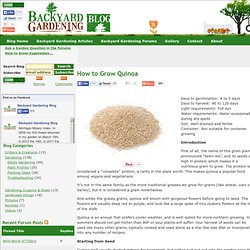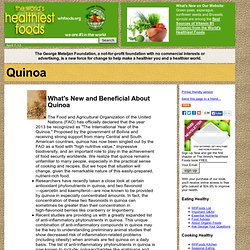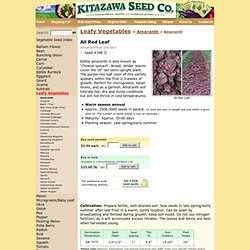

Online teachers resource websites. Diy. How to Grow Quinoa. Days to germination: 4 to 5 days Days to harvest: 90 to 120 days Light requirements: Full sun Water requirements: Water occasionally during dry spells Soil: Well-drained and fertile Container: Not suitable for container growing Introduction First of all, the name of this grain plant is pronounced “keen-wa”, and its seeds are high in protein which makes it a nutritious grain to grow.

The protein is considered a “complete” protein, a rarity in the plant world. This makes quinoa a popular food among vegans and vegetarians. It’s not in the same family as the more traditional grasses we grow for grains (like wheat, oats or barley), but it is considered a grain nonetheless. And unlike the grassy grains, quinoa will bloom with gorgeous flowers before going to seed. Quinoa is an annual that prefers cooler weather, and is well-suited for more northern growing.
Starting from Seed Dig up your soil beforehand to loosen the earth and to kill any early weeds. Growing Instructions Containers Top of page... Quinoa. What's New and Beneficial About Quinoa The Food and Agricultural Organization of the United Nations (FAO) has officially declared that the year 2013 be recognized as "The International Year of the Quinoa.

" Proposed by the government of Bolivia and receiving strong support from many Central and South American countries, quinoa has now been singled out by the FAO as a food with "high nutritive value," impressive biodiversity, and an important role to play in the achievement of food security worldwide. We realize that quinoa remains unfamiliar to many people, especially in the practical sense of cooking and recipes. But we hope that situation will change, given the remarkable nature of this easily-prepared, nutrient-rich food. Researchers have recently taken a close look at certain antioxidant phytonutrients in quinoa, and two flavonoid—quercetin and kaempferol—are now known to be provided by quinoa in especially concentrated amounts.
Quinoa, cooked0.75 cup(185.00 grams) NutrientDRI/DV. Three Sisters Garden - Thai Sweet Basil. All Red Leaf. Amaranthus tricolor All Red Leaf Edible amaranth is also known as ‘Chinese spinach’.

Broad, tender leaves cover the 16" tall semi-upright plant. The purple-red leaf color of this variety appears within the first 2-3 weeks of growth. Perfect for microgreens, salad mixes, and as a garnish. Warm season annualApprox. 2500-3000 seeds in packet. Buy in bulk Available in 1-lb increments, minimum 1 lb. Cultivation: Prepare fertile, well-drained soil.
Please note: Maturity, adaptability and disease tolerance may differ under your specific climate and/or growing conditions. How to Grow Mustard. January 23rd, 2009 Email 148 users recommend Phillip Harvey Louisa Rawle Tiné A field of mustard.

Photo: Phillip Harvey Mustard is an ancient plant that’s full of appeal for contemporary gardeners. Mustard in all its forms—shoots, leaves, flowers, whole seed, powdered, or prepared—is a flavorful, low-fat way to punch up any savory food. If you’ve ever traveled to California’s wine country in early spring, you may have seen the vineyards awash in yellow flowers. Mustard seed contains no cholesterol, only trace amounts of vegetable fat, and about 25 percent protein. Today, mustard is second in demand to pepper among spices in the United States. Over the years, mustard has been imbued with curative powers.
All mustards come from the Cruciferae, a family that includes broccoli and cabbage. Leek. The leek is a vegetable that belongs, along with onion and garlic, to the genus Allium, currently placed in family Amaryllidaceae, subfamily Allioideae.[1] Historically many scientific names were used for leeks, which are now treated as cultivars of Allium ampeloprasum.[2] Two related vegetables, elephant garlic and Kurrat, are also cultivars of A. ampeloprasum, although different in their uses as food.

The edible part of the leek plant is a bundle of leaf sheaths that is sometimes erroneously called a stem or stalk. Form[edit] Cultivars[edit] Leek cultivars may be treated as a single cultivar group, e.g. as Allium ampeloprasum 'Leek Group'.[3] The cultivars can be subdivided in several ways, but the most common types are "summer leeks", intended for harvest in the season when planted, and overwintering leeks, meant to be harvested in the spring of the year following planting. Growing[edit] Leeks are easy to grow from seed and tolerate standing in the field for an extended harvest.